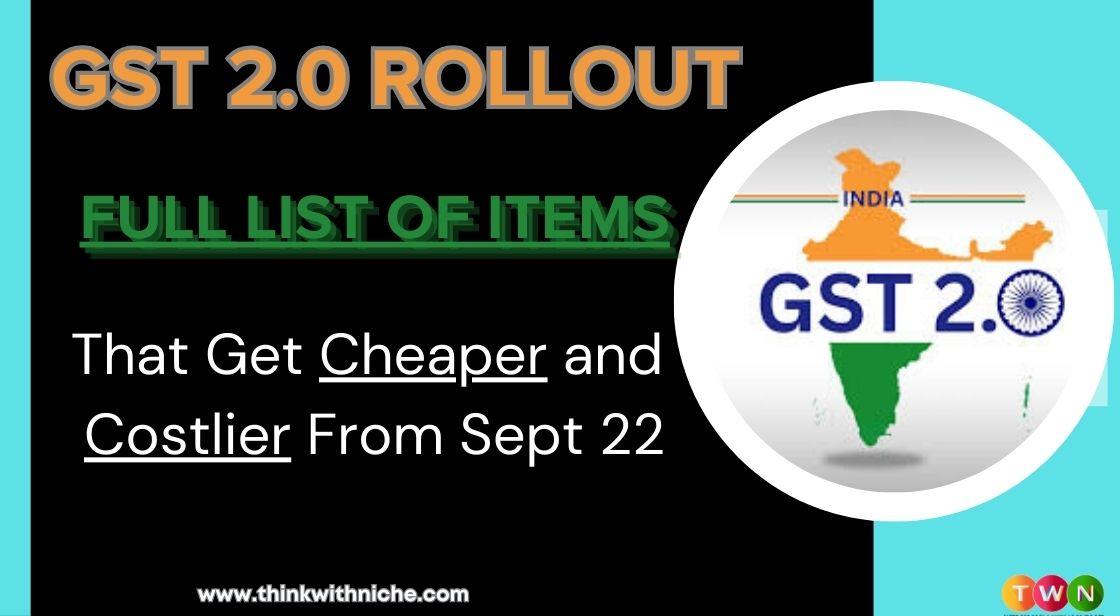GST 2.0 Rollout Today: Full List of Items That Get Cheaper and Costlier From Sept 22

Blog Post
Today, September 22, 2025, is a landmark day for India’s economic framework: GST 2.0, the next-generation Goods and Services Tax reform, comes into force across the country.
Approved by the 56th GST Council under the leadership of Finance Minister Nirmala Sitharaman, this reform simplifies the indirect taxation system by eliminating the 12% and 28% GST slabs and consolidating items into two major rates — 5% for essential or merit goods, and 18% for most other goods and services — along with a 40% sin tax for luxury and demerit items.
Consumers are expected to see measures of relief immediately: food staples, everyday personal care items like soaps and toothpaste, certain kinds of household electronics and building materials, and even insurance premiums are among the categories seeing reduced GST charges.
The government estimates that these changes could leave approximately ₹2 lakh crore more in citizens’ hands via lower taxes and increased disposable income.
At the same time, Authorities acknowledge that there will be a revenue shortfall of about ₹48,000 crore owing to the rate cuts, but expect that the boost in consumption will more than fill this gap over time.
For many households, especially middle- and lower-income ones, the timing is crucial: coming just ahead of the festive season, GST 2.0 aims to amplify purchasing power and stimulate demand.
GST 2.0 Implementation Today – Check Complete List of Price Changes
Today, September 22, 2025, marks a monumental day in India's economic history as the GST 2.0 reforms officially take effect. In a move hailed by both policymakers and industry experts, the GST Council, under the leadership of Finance Minister Nirmala Sitharaman, has ushered in a streamlined, two-slab tax structure.
This overhaul aims to simplify a system that has long been criticized for its complexity, replacing the previous four-tiered system with just two primary rates: 5% for essential goods and 18% for most other goods and services.
A special 40% "sin tax" slab has also been introduced for a select list of luxury and demerit goods. This historic reform is expected to provide substantial relief to middle-class households and stimulate consumption just in time for the festive season.
History of GST in India
The Goods and Services Tax (GST) is a comprehensive indirect tax that replaced a wide range of earlier levies on goods and services, unifying them into a single system. By covering the entire supply chain—from production to consumption—GST became one of India’s most significant tax reforms in recent history.
When was GST introduced in India?
The idea of GST is not new to the world. France was the first country to adopt a similar tax model back in 1954, and since then, more than 160 countries have implemented it in some form. Malaysia was among the latest nations to switch to GST in 2015.
In India, GST officially came into effect on July 1, 2017, with a dual tax structure comprising Central GST (CGST) and State GST (SGST).
Who introduced GST in India?
The groundwork for GST was laid over many years. In 2014, then Finance Minister Arun Jaitley introduced the Constitution Amendment Bill in Parliament. The following year, in May 2015, the Constitution (122nd Amendment) Bill was passed in the Lok Sabha.
Subsequently, four key legislations—the Central GST Bill, 2017, the Union Territory GST Bill, 2017, the Integrated GST Bill, 2017, and the GST (Compensation to States) Bill, 2017—were passed by both Houses of Parliament by April 20, 2017. This set the stage for the official launch of GST on July 1, 2017.
Also Read: Indian Economy in Focus-FY25 Q4 Recovery Sparks Fresh Growth Hope for FY26
Evolution of GST Bill and GST Act in India
The roots of GST in India date back to the year 2000, during the tenure of Prime Minister Atal Bihari Vajpayee. His government set up an Empowered Committee of State Finance Ministers to examine the possibility of implementing GST, drawing on their experience with Value Added Tax (VAT).
In 2004, the Fiscal Responsibility and Budget Management (FRBM) Committee also recommended the introduction of GST. Later, during the Union Budget of 2006–07, the Finance Minister announced that GST would be rolled out by April 1, 2010. However, multiple challenges and delays pushed the timeline further.
In 2011, the Constitution (115th Amendment) Bill was introduced to incorporate GST provisions. The Bill was reviewed by a Standing Committee, but it lapsed with the dissolution of the 15th Lok Sabha in 2014. This led to the introduction of a fresh Constitutional Amendment Bill in the same year, eventually culminating in the rollout of GST in 2017.
GST 2.0 – What Has Changed?
-
5% Slab: Reserved for essential goods and affordable services.
-
18% Slab: Covers most goods and services, simplifying the earlier complex structure.
-
40% Sin Tax: Applied on products like alcohol, tobacco, pan masala, betting, and luxury categories.
By streamlining the tax slabs, the government expects easier compliance, fewer disputes, and improved transparency in tax administration. Economists project that this reform could add 0.7–0.8 percentage points to India’s GDP growth in FY26 by increasing demand.
What Gets Cheaper Under GST 2.0
The most significant change for the average consumer is the downward movement of a large number of items from the 12% and 28% slabs into the lower 5% and 18% brackets. This move is designed to make daily life more affordable and boost discretionary spending.
1. Everyday Household Essentials
The price of daily-use products is set to fall as they shift from the 12% or 18% slab to the new 5% rate. This change will directly impact the monthly budgets of millions of families. The list of items includes:
-
Packaged food and dairy products: Items like ghee, condensed milk, butter, cheese, snacks, biscuits, and many types of packaged juices will now be significantly cheaper.
-
Personal care items: Toothpaste, soaps, shampoos, hair oil, and shaving creams are among the products that have moved to the 5% slab from the previous 18%, making personal hygiene more affordable.
-
Other common goods: This category includes bicycles, stationery items, and even household candles, all seeing a significant tax reduction. Indian breads like roti, chapati, and paratha will now be tax-free.
2. Appliances and Electronics
In a massive relief for the middle class, a majority of white goods and large electronics have been moved from the high 28% slab to the 18% standard rate. This change is a direct response to the argument that items like air conditioners, refrigerators, and large-screen televisions are no longer luxuries but essentials in modern households. Experts estimate that this tax cut will lead to an average price reduction of 7-8%, making these big-ticket items more accessible and potentially spurring a surge in sales.
-
Air Conditioners and Refrigerators: These will see a notable price drop, providing relief from the summer heat and making energy-efficient models more affordable.
-
Televisions and Dishwashers: Prices for these appliances, which were once considered premium, will now be more competitive.
-
Cement: In a major boost to the housing and construction sector, the GST on cement has been reduced from 28% to 18%. This is expected to lower construction costs, make homes more affordable, and stimulate real estate activity.
3. Automobiles and Two-Wheelers
The automobile sector is one of the biggest beneficiaries of the GST 2.0 reforms. The GST on small cars and two-wheelers has been reduced, which is expected to revive demand and provide a much-needed push to the industry.
-
Small Cars: Small cars (with a length under 4 meters and petrol engines up to 1200cc or diesel engines up to 1500cc) will now be taxed at 18%, down from the previous 28% plus cess. This is a significant relief for first-time car buyers.
-
Two-Wheelers: Motorcycles with an engine capacity of 350cc and below, a staple of Indian mobility, have also been moved from the 28% to the 18% slab.
-
Electric Vehicles (EVs): In a nod to sustainable mobility, the GST rate on electric vehicles remains unchanged at a low 5%, reinforcing the government’s commitment to green transportation.
4. Insurance and Financial Services
Recognizing the critical role of insurance in financial security, the GST Council has provided major relief. Insurance premiums, which previously attracted an 18% GST, have now been fully exempted from tax. This move is a landmark step towards increasing insurance penetration and is expected to encourage millions of middle-income households to invest in life and health coverage, aligning with the government's vision of "Insurance for All by 2047."
What Stays Expensive Under GST 2.0
While many items are getting cheaper, the government has been clear that luxury and demerit goods will face a higher tax burden. The new 40% "sin tax" slab is designed to discourage the consumption of these items while generating a significant revenue stream for the government.
-
Tobacco and Alcohol: Products like tobacco, pan masala, and cigarettes will continue to be heavily taxed under the new 40% slab. The existing high GST rates and compensation cess will remain in place for these items.
-
Online Betting and Gaming: Online betting and gaming platforms have also been placed in the 40% "demerit" category, significantly increasing the tax incidence on the sector.
-
Petroleum Products: Despite widespread demand, petroleum products like petrol and diesel remain outside the purview of the GST framework. This means that fuel prices will not be impacted by the new reforms.
-
Luxury Vehicles and Imported Goods: The GST on larger luxury cars and SUVs has been raised to the 40% slab, and higher import duties will continue to make foreign goods more expensive.
Why This Reform Matters for the Indian Economy
The GST 2.0 reforms are more than just a tax cut; they are a strategic economic stimulus with far-reaching implications.
-
Economic Boost: Finance Minister Nirmala Sitharaman has stated that these reforms are expected to inject up to ₹2 lakh crore into the economy. By putting more cash in the hands of consumers, the government anticipates a strong surge in demand, which will drive manufacturing and service sectors.
-
Simplification and Compliance: The new two-slab structure simplifies the entire tax process, making it easier for businesses, especially small and medium enterprises (MSMEs), to comply. This reduction in compliance burden will save time and money, allowing businesses to focus on growth.
-
Boosting Specific Sectors: The targeted tax cuts on automobiles, consumer durables, and construction materials are expected to provide a direct impetus to these key sectors. For example, lower prices on small cars and two-wheelers are projected to revive a sector that has faced fluctuating sales in recent years.
-
Positive Market Sentiment: The stock market has already reacted positively to the news. On the day of the announcement, the Nifty 50 surged, with auto, FMCG, and consumer durable stocks showing the sharpest gains. This reflects investor confidence in the long-term growth potential of the Indian economy.
In essence, the GST 2.0 rollout is a bold move designed to simplify the tax system, ease the financial burden on the common man, and create a virtuous cycle of increased consumption and economic growth.
Conclusion
The rollout of GST 2.0 marks a new era in India’s taxation system. By simplifying slabs and reducing tax rates on essentials, consumer goods, and automobiles, the reform is set to boost affordability, drive consumption, and strengthen economic growth. While luxury and sin goods remain heavily taxed, the overall shift brings relief to middle-class households, small businesses, and large industries alike.
With its potential to streamline compliance and enhance transparency, GST 2.0 is more than just a tax reform — it is a growth catalyst that could make India’s economy more inclusive, competitive, and resilient in the years ahead.
You May Like
EDITOR’S CHOICE












